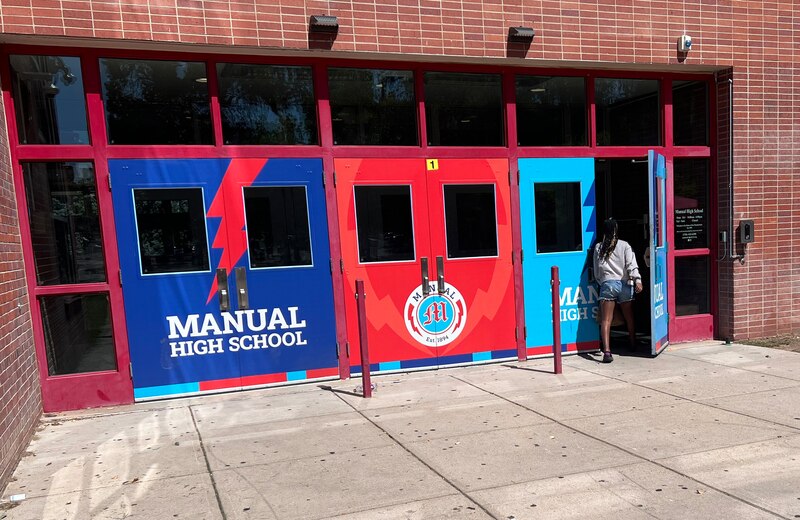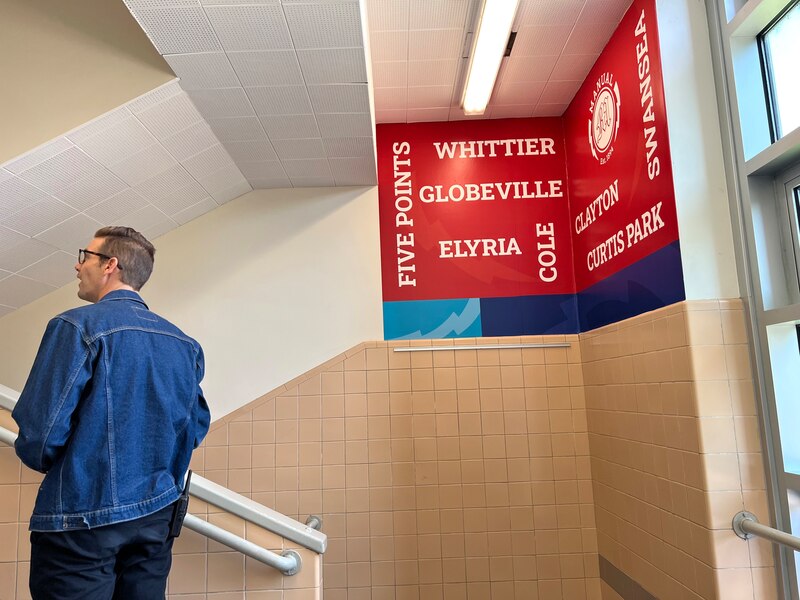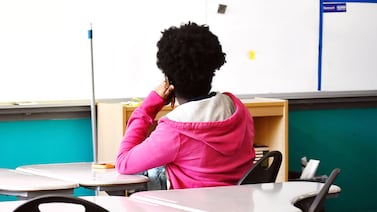Sign up for Chalkbeat Colorado’s free daily newsletter to get the latest reporting from us, plus curated news from other Colorado outlets, delivered to your inbox.
A boost in academic progress, improved graduation rates, and more students going to college or career training has put Denver’s Manual High School on track to exit a state watchlist for low performance.
Manual had been on Colorado’s so-called accountability clock, which ticks toward state intervention, for more than a decade. Principal Chris DeRemer has been at Manual just as long, first as a teacher and now as an administrator. He said Manual’s move off the watchlist is a testament to the power of strong teachers and the importance of school culture and student attendance.
Manual’s approach offers potential lessons for other Colorado schools that have struggled with student outcomes.
“The theory of action was that our teachers are so good and our staff is so good that if we get our kids here and they feel like they can take risks, they’ll grow,” DeRemer said.
Manual is one of Denver’s oldest high schools. It has a long list of prominent alumni, including former Denver mayors Michael Hancock and Wellington Webb.
It also has a long history of academic struggle that led Denver Public Schools to experiment with interventions to boost student achievement. Many of them, including closing Manual in 2006 and reinventing and reopening it a year later, were painful for the community and disheartening for students, almost all of whom are Black and Latino.
DeRemer is Manual’s ninth principal since it reopened in 2007.
Walking the second-floor hallway at Manual this week, DeRemer called out to Abria, a senior at the school who he said exemplifies the school’s philosophy.
“Once you get to know the staff here, it’ll feel more like a family, and you’ll have people who have your back,” Abria said, before ducking into a classroom to talk to a college counselor.

Improved academic rating brings ‘new era’ to Manual
Manual has been on the accountability clock since 2013, when it earned the lowest state rating of “turnaround,” signified by the color red. The state ratings are based on several factors, including a high school’s graduation rate, how its students score on standardized tests, and how much progress they make on those tests year over year.
Schools face state intervention after five years of low ratings. Because of various pauses to the accountability clock, Manual didn’t get that intervention until 2020.
Instead of imposing one of the harsher sanctions allowable by law, such as closing a school, the State Board of Education treated Manual the same way it has most schools on the clock. It ordered Manual to follow an innovation plan that gives the school more flexibility in hiring, budget, and curriculum in the hopes that those changes will lead to higher student achievement.
Manual had already had its own innovation plan for years that was approved by the Denver school board. But being on the clock meant more scrutiny from state officials and public hearings before the state board.
To get off the clock, schools must earn one of the top two state ratings for two years in a row. Last year, Manual got halfway there when it earned a yellow “improvement” rating. This year, preliminary ratings released earlier this week showed Manual has been rated yellow again for 2024.
“This academic rating rings in a new era for Manual,” DeRemer wrote in a letter home to Manual families this week. “It also shows that Manual’s students are capable of accomplishing as much or more than any of their peers in the city of Denver and in the state of Colorado.”

Using college-level courses helped instructional rigor
Since it reopened in 2007, Manual has undergone numerous leadership changes and a steady stream of shifts in its philosophy and academic approach. But DeRemer said its recent success is not the result of a new out-of-the box idea.
“We really dedicated ourselves to the quality of daily instruction,” he said. “It’s not that fancy.”
DeRemer added, “I think there’s a misconception that school turnaround can happen quickly. We’ve just built this every year and gotten a little better every year.”
Manual has for years offered students the opportunity to take college-level classes and earn college credit before they graduate. Manual also has a hands-on career education program called the Med School at Manual in which students can earn industry certifications that would allow them to work as an EMT or pharmacy technician, for example, right out of high school.
Those college-level opportunities, DeRemer said, “upped the rigor of our classes.”
That’s especially true in math. While Manual students’ raw scores on the PSAT and SAT tests they took last spring were still below the state and district average, Manual students made above-average progress year over year, as measured by the state’s median growth percentile.
Students who are behind need a median growth percentile above 50 to make progress toward catching up. Manual’s median growth percentile in math this past spring was 59. The percentile for students in the college-level math courses was a whopping 84, DeRemer said.
How did that happen?
“Because our math teacher is so phenomenal,” he said.

Manual’s new school motto for students: ‘Expect Excellence’
Manual’s increased graduation rate — 91% of students graduating within six years of starting high school — and its high matriculation rate — 70% of graduates going onto college or a career training program — also helped propel its rating from red to yellow.
The rating doesn’t take daily attendance into account, but DeRemer said making sure students are in class has been key to Manual’s success. The school’s attendance rate rose from 77% in 2022-23 to 84% last year with the help of contests, gift card giveaways, and other tactics.
The school has more than 20 clubs, including a Black Student Alliance, a Dungeons and Dragons group, and a chess club run by an alumnus. But there are eligibility requirements for sports and other extracurricular activities, DeRemer said. If students don’t have an attendance rate of 85% or better, they can’t play on the team.
Manual has also worked to make the school more safe and welcoming. It has an abundance of mental health staff for a population of 350 students, including a full-time school nurse, a full-time school psychologist, two social workers, and a restorative practices dean, DeRemer said. It also has two part-time art therapists and a counselor who specializes in substance abuse.
Denver Broncos player Patrick Surtain II donated a new STEAM lab for science, engineering, technology, art, and math. Manual also has a “rap lab” with recording equipment and lessons about lyricism, made possible by a grant from the University of Colorado.
Manual also has fresh paint. The school is blanketed in Manual’s red and blue thunderbolt logo, and DeRemer recently added the names of neighborhoods where students come from — Whittier, Clayton, Cole, Five Points, and others — to the hallways and library. Every student gets a T-shirt with the Manual logo and a bracelet that says “Expect Excellence.”
“You have excellence in you that we expect to see every day,” DeRemer said of the meaning. “You come from Cole and you’re bilingual? That’s excellent. Show that off in the classroom.”
While DeRemer is celebrating the recent news, he acknowledges Manual still has work to do.
“We know it’s fragile,” DeRemer said. “Getting off the clock is a necessary step, but that doesn’t mean all our kids are winning. Until all our kids are winning, we have a lot of work to do.”
Melanie Asmar is the bureau chief for Chalkbeat Colorado. Contact Melanie at masmar@chalkbeat.org .






